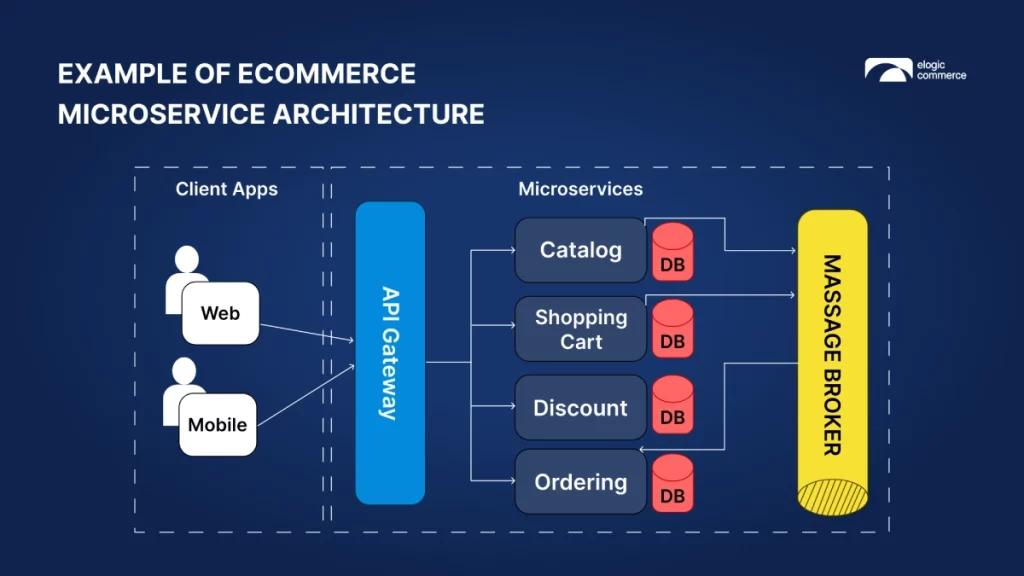Amazon has long kept its infrastructure a secret. They started accepting third-party sellers in the early 2000s and grew into an ecommerce giant in only two decades. Still, it was hard to imagine how a single marketplace could manage high-volume transactions with millions of products with ease.
So what made Amazon so successful? An excellent business strategy and… ecommerce microservices.
While Amazon had to invent their way into the future, many stores have now leveraged microservice architecture to scale their businesses. Netflix, Zalando, Alibaba – they all literally dissected their monolithic systems into small blocks of subservices that smoothly work together like a Lego puzzle and grow alongside their users’ ambition.
At Elogic, we’ve been operating in the market since 2009 and not only seen the change but also taken part in it. Having helped dozens of stores transition to microservices, we know how difficult it might be to make sense of the emerging technologies. Especially if you bet everything on one replatforming project.
Read on to learn about the essence of ecommerce microservices architecture and how it can help you overcome the limitations of traditional systems.
What Is Ecommerce Microservices Architecture?
Microservices architecture is a type of ecommerce architecture that breaks down the entire system into small, independent services, each responsible for a specific business function. Unlike monolithic architectures, where all functionalities are tightly coupled in a single codebase, microservices offer the ability to decouple different components—such as product catalog, payment processing, and customer reviews—allowing them to operate independently.

This modular and headless structure offers significant flexibility, enabling businesses to scale, update, and deploy individual services without affecting the entire system. As a result, ecommerce platforms can respond faster to market changes, optimize resources, and deliver a seamless customer experience, all while minimizing downtime and enhancing overall performance.
The microservices approach is not just about technology; it’s about creating a resilient, adaptable, and high-performing software system.
What Are Microservices?
Microservices are a game-changer in software architecture, breaking down complex applications into a network of small, independent services, each with a clear, focused purpose.
Read more: commercetools vs Adobe Commerce: A Side-by-Side Comparison
Imagine each microservice as a specialized team member—one handles user authentication, another processes orders, while another keeps tabs on the shopping cart and inventory. These services work together, communicating through well-defined APIs, to create a powerful, cohesive system.

What makes microservices so appealing is their flexibility: you can update, scale, or swap out any service without touching the rest of the application. This modular approach not only speeds up development but also boosts the system’s resilience, ensuring that if one service stumbles, the rest keep running smoothly. In the world of ecommerce, this agility gives you a true competitive advantage.
Benefits of Ecommerce Microservices
Having completed dozens of ecommerce projects, we at Elogic Commerce know how microservices benefit entrepreneurs:
- Reduced time to market. Microservices allow merchants to stay agile in the dynamic world of ecommerce. Because your deployments work separately from each other, you can have several teams work on several store functionalities at the same time, therefore speeding up the development cycle.
- Minimal downtime. Online stores can’t afford to stay out of business even if they need some repairs or upgrades. Thanks to microservices, you can mend anything on the hoof by taking care of the malfunctioning module while the rest of the system continues operating.
- Customization opportunities. With microservices, any UI fine-tuning is a cakewalk, so you can tweak your e-store as much as you like to take industry changes in their stride and provide the ultimate shopping experience for your clientele.
- Cost efficiency. Some may say that microservices require significant investments (indeed if you consider license fees of commercetools); however, the transition from monolithic to microservices architecture can be performed module by module. Besides, you can also optimize your resource usage for each service and save a pretty penny on serverless / cloud hosting.
Embracing the cloud. Entering the major league of ecommerce business is impossible without harnessing the power of the cloud. With the cloud-native nature of microservices, it can be done effortlessly. Moreover, you can host each service on a different cloud to optimize infrastructure costs and reduce the risk of a single resource overload.
Ecommerce Microservices Architecture: A Close-Up View
To grasp the true power of ecommerce microservices architecture, let’s zoom in on its key components. Each layer plays a vital role in creating a scalable, flexible, and high-performing ecommerce platform.

User interface (UI)
The UI layer is where customers interact with your ecommerce platform. In composable commerce that is rooted in the microservice architecture, it’s also called “glasses”. Whether it’s through a responsive website, a mobile app, or even a chatbot, this layer is the gateway to your services. The UI connects directly to the underlying microservices via APIs, ensuring that users receive real-time, dynamic content tailored to their needs.
Routing layer
The routing layer acts as the traffic manager for your platform, directing requests from the UI to the respective microservices. Using advanced API gateways and routing mechanisms, this layer ensures that data flows efficiently and securely, optimizing the platform’s performance while protecting against potential threats.
Microservices
At the core of the architecture are the microservices, each responsible for a specific business function — be it payment processing, order management, or customer reviews. These services operate independently, allowing for quick updates and scaling without disrupting the entire system. This modularity gives ecommerce platforms the agility to adapt to market changes and customer demands.
Databases
The database layer underpins the entire architecture, storing and managing the vast amounts of data generated by your platform. Different microservices may require different types of databases, from traditional SQL databases for structured data to NoSQL options for more complex, unstructured data. By separating data storage into specialized databases, your platform can achieve faster access times and improved overall efficiency.
Why Are Ecommerce Microservices Important?
Now, when customer expectations evolve at turbo speed, staying competitive requires more than just a robust online platform—it demands agility, scalability, and resilience. This is where ecommerce microservices shine.
Read more: Composable Commerce: How commercetools Can Help You Scale Fast and Boost Your ROI
Microservices allow businesses to break free from the limitations of traditional monolithic architectures by decoupling the various functions of an ecommerce platform into independent, manageable services. This approach is crucial for several reasons:
- Scalability. As your business grows, so does the demand on your platform. Microservices enable you to scale individual components, like payment processing or product search, without affecting the entire system. This means you can meet increased traffic and transaction volumes head-on without sacrificing performance.
- Agility. The ability to rapidly deploy updates and new features is a game-changer in the competitive eCommerce landscape. With microservices, you can innovate faster, rolling out improvements and new functionalities without downtime, giving you the edge in responding to market trends and customer needs.
- Resilience. In a monolithic system, a single failure can bring down your entire platform. Microservices, however, operate independently, meaning that an issue in one service won’t necessarily impact the others. This isolation minimizes downtime and ensures a more reliable shopping experience for your customers.
- Flexibility. Microservices architecture supports a best-of-breed approach, allowing you to integrate the latest technologies and services that best fit your business needs. Whether it’s adopting a new payment gateway or enhancing your search capabilities, microservices provide the flexibility to build a platform that is uniquely yours.
At Elogic, we’ve seen firsthand how microservices architecture can transform businesses across various industries. For instance, when we partnered with a Saudi-based luxury beauty marketplace to implement a headless PWA using microservices, the result was a highly flexible and scalable platform that significantly enhanced the customer experience and reduced time to market.
In essence, ecommerce microservices are not just a technical choice—they’re a must for any online business looking to thrive. By embracing the headless commerce architecture, you can help your business to adapt quickly, scale efficiently, and deliver a seamless customer experience to your clients.
Summing It Up
The contemporary ecommerce realm witnesses a cut-throat competition among entrepreneurs, the success in which can be achieved via leveraging a flexible, scalable, and fault-resistant professional solution, compatible with state-of-the-art technologies. Old-school monolithic ecommerce websites and apps can’t provide these pivotal efficiency-driving characteristics, so e-stores can hit it big by harnessing microservices architecture. Thanks to their containerized nature, such products tick all the above-mentioned boxes and usher in numerous mission-critical boons, including shorter time to market, minimal downtime, and broad customization capabilities. Ecommerce companies can make the most of these benefits by partnering with competent experts in the field who will deliver a smoothly functioning and user-friendly bespoke microservices solution. At Elogic, we have a clear understanding of how to take your online store to the next level with a modern, resilient, and high-performing platform.
Elevate your online presence with Elogic’s expert Solution Architecture services.
Learn moreFrequently asked questions
What is microservices architecture?
It is a way of organizing elements of a software product when its containerized modules exist as independent units with a separate scope, operation logic, and database. The connection between blocks is performed via a network of APIs, which enables loose coupling of components across the system.
What advantages do microservices have over monolithic architecture?
The arrangement of back-end elements as a set of standalone containers allows for the individual development, modification, deployment, and testing of each unit within the system. Besides, it makes the code in them transparent, permits the employment of multiple tools and languages for their creation, simplifies bug detection, and rules out cascading faults.
What is an example of a microservice architecture?
A typical structure of a microservices e-store contains a web or mobile app UI, which relies on an array of APIs functioning on the routing layer to enable access to containerized capabilities. A garden-variety ecommerce site has a product microservice (product catalog, product search, prices and promotions), an inventory microservice, an order microservice (orders, returns, delivery, payments), and a customer microservice, each with its own database.
What are the benefits of microservices architecture for ecommerce companies?
By embracing microservices architecture, an ecommerce organization can shorten the time to market of the e-store and its separate elements, minimize downtime in case of its upgrading or repairing, integrate external professional systems, provide a seamless omnichannel shopping experience to the clientele, and adopt a mild expenditure curve.



